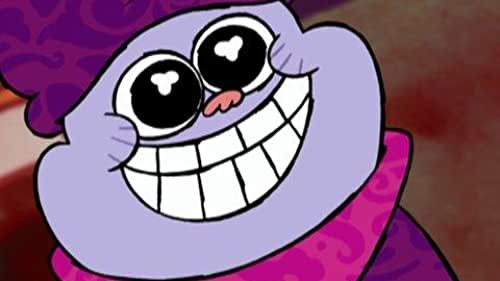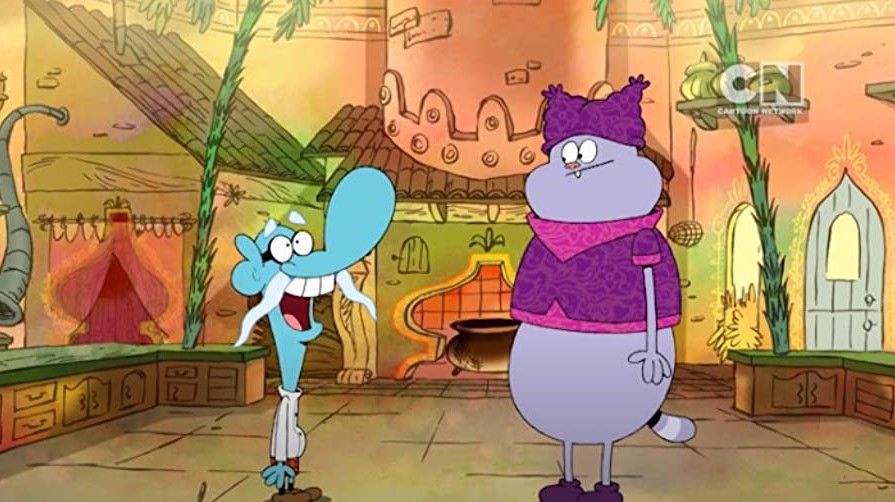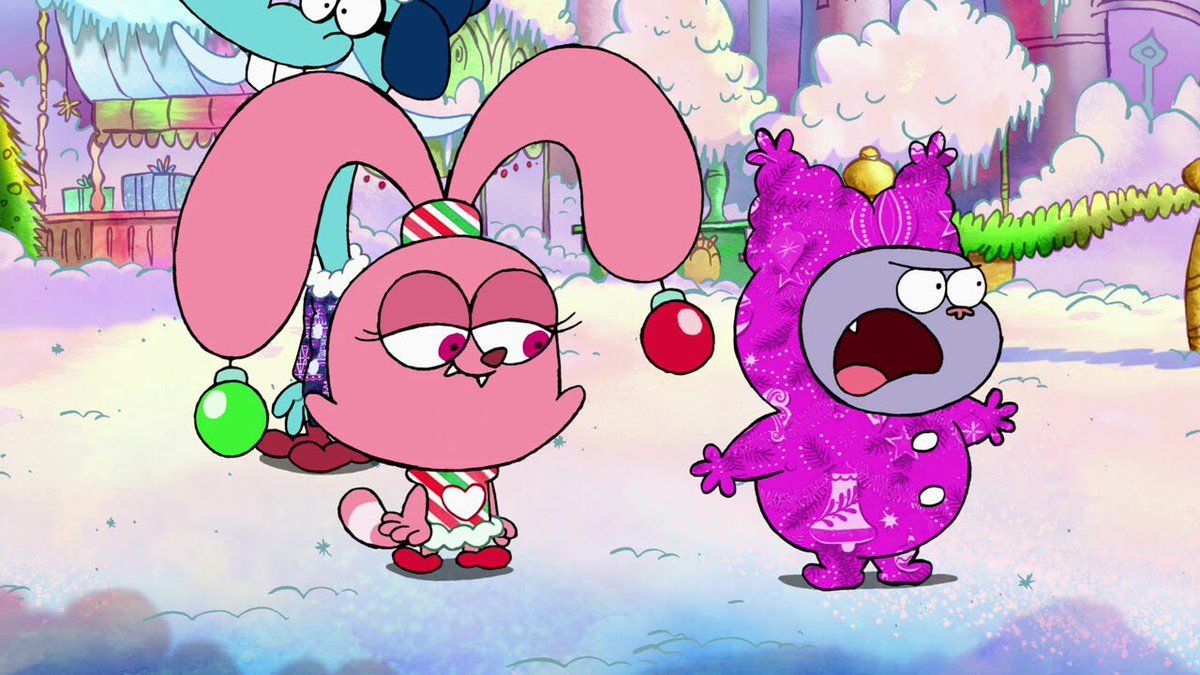The Funny Toon Show With the Janitor
In the decade after its debut, Nickelodeon's SpongeBob SquarePants undeniably inverse the landscape of American cartoons. On top of the series' likably endearing and marketable lead, the Nicktoon's unique out-of-the-box approach to cartoon comedy through mixed-media visual gags and quotable not-sequiturs have made it a cornerstone in the funny bones of generations ever since, essentially becoming as influential a comedy serial equally The Simpsons .
For years post-obit SpongeBob, major networks were vying to recreate the "secret formula" of SpongeBob's appeal by essentially going back to the Hanna-Barbera/ Looney Tunes approach of classically character-based cartooning. The 2000s saw a push for series to have basic premise and madcap cast of characters that could reliably generate character-driven situation comedies with a baroque and overall zany sensibility. While Cartoon Network, one of Nickelodeon's chief competitors in children's animation, had made their attempts at creating the adjacent SpongeBob with series like Military camp Lazlo and My Gym Partner's a Monkey , 2007'south Chowder proved non but to be the most-worthy successor to the SpongeBob brand of comedy, but an evolution of it.

Created by former Spongebob and The Grim Adventures of Baton and Mandy storyboard creative person C.H. Greenblatt, the serial follows the adventures of young apprentice Chowder, voiced past Nicky Jones, equally he learns the ways of the kitchen at the foot of his mustachioed cooking master Mung Daal, played by Dwight Schultz. A pseudo-workplace one-act/educational evidence, each episode follows Chowder as he learns to help Mung craft a new fantastical dish for his catering company in the culinary urban center of Marzipan Urban center, where food is omnipresent in nigh every aspect of everyday life and even comes to life. Rounding out the cast is the musclebound rock monster janitor Schnitzel (John DiMaggio), Mung'southward dowdy pixie sprite married woman Truffles (Tara Strong) and a wooly mammoth fruit monger named Gazpacho (Dana Snyder). Amid the serial' stylistic inspirations of Dr. Seuss and Jim Henson, Chowder owes a lot of its identity to the art of animation itself and its classically comedic roots in Tex Avery and the Looney Tunes.
Chowder'due south greatest strength is in how wildly limitless its scope is in practically every aspect. Along with the prove's wildly rubberband and expressive animation, the globe of Marzipan City and the series' imaginative arroyo to cooking leave itself open to be painted in a broad visual and conceptual brush of stories and settings that the characters must embark on to consummate an order. Ingredients and dishes accept fantastically punny names and magical properties that plough an everyday recipe into an adventure. Not merely that, the series is non bound by whatsoever sense of logic or consistency, operating on a joyously fluid reality and childlike spontaneity to ensure that each episode and joke gets the biggest laugh possible from the viewer. Every visual flourish and line of dialogue is delivered in the service of existence funny.

More than than arguably whatever other Cartoon Network series of its era, comedy is the driving force backside everything Chowder puts fourth. Near the dawn of series like Gamble Time , Steven Universe and Regular Show that sparked a revolution of infusing cartoons with long-form dramatic storytelling and graphic symbol insight, Chowder solely aimed to elicit big laughs in the cartoon tradition. While non brusque on moments with sincerity in its characters, Chowder'south first social club of business is to be silly by employing insane facial expressions and relentless wordplay. The work put in past Greenblatt and company operated on the belief that cartoons should be fun and limited simply past their ain sense of humor every bit they utilized every medium of animation at their disposal, from puppets and end-movement, to CGI and even live-activeness.
In a word, the series' brand of comedy is unexpectedly meta. Like SpongeBob, the greatest laughs Chowder is able to accomplish are through an assortment of verbal not-sequiturs and mixed media cutaway gags, simply what makes Chowder especially funny is in how it utilizes these comedic elements and further animation techniques in the service of reality-angle meta-humour. Chowder'south bread-and-butter is in how cocky-enlightened its comedy is in openly acknowledging its very nature every bit a Boob tube cartoon. An average episode will brand coincidental reference to how the characters knowingly participate in an 11-minute episode format and that they reside in a goofy kids' evidence, commenting on things such equally expensive blitheness costs and diegetic voiceover. Animation tropes and production lingo will work its way into the story to poke holes in the plot and even suspension the fourth wall by speaking straight to the audience. One episode famously presented the dilemma of the prove running out of an animation budget and showed the voice cast in live-activity running a car launder to raise funds to get the drawing'southward animation back. While Chowder is far from the only series to utilise meta-humor, the extent to which the veil is broken and how the series does so brand information technology charmingly post-modernistic for a Cartoon Network prove.

Cutting from the same cloth as SpongeBob and even featuring some of the aforementioned coiffure, Chowder'due south comedy aimed farther than to be some other SpongeBob wannabe and became a mod Cartoon Network hit, if even for simply a moment. Despite the evidence'southward popularity, the series was abruptly canceled in 2009 after a alter of executive leadership at the network wanted to focus less on cartoons and more on live-action diversity programming, cutting its run shorter than most of the Cartoon Network hits that came before and after. While information technology does take its fans, Chowder has yet to achieve the level of nostalgic reverence, cult fandom or even second-life in internet meme civilisation that the shows of its era accept accomplished like Regular Prove or The Amazing World of Gumball .
Chowder marked i of the terminal breaths of an era for Cartoon Network. Cartoons in the classic Looney Tunes tradition have been equated to freeform jazz in how elastically conceptual and fluidly visual its attempts at comedy were from moment-to-moment. Chowder's board-driven approach to gag-focused drawing one-act runs along the same lines as the aureate age of animation, striving to get the biggest possible laugh in whatever given shot through character and dialogue-based jokes. While non officially nether the original banner of Drawing Cartoons, Chowder's off-the-wall animated antics and meta humor made it one of the network'due south most overtly cartoony series ever.
jonestheivereeted.blogspot.com
Source: https://collider.com/chowder-cartoon-network-underrated-modern-classic/
0 Response to "The Funny Toon Show With the Janitor"
Post a Comment